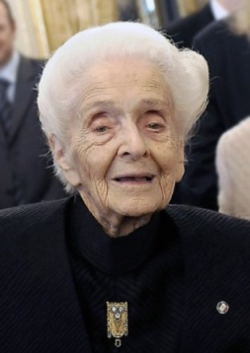Rita Levi-Montalcini

© Presidency of the Italian Republic
- Born
- 22 April 1909
- Died
- 30 December 2012 (age 103)
Rita Levi-Montalcini was a Nobel-prize winning neurologist who researched and discovered the critical chemical tools that the body uses to detect cell growth and build nerve networks. This paved the way for the study of how those processes can go wrong in diseases like dementia and cancer.
Rita was born in Turin, Italy in 1909. Her family believed that women should be wives and mothers, but Levi-Montalcini knew that she did not wish to marry and persuaded her family to be allowed to study medicine. Levi-Montalcini graduated with a degree in medicine and surgery in 1936 at the University of Turin, and then worked there, learning a technique for silver staining nerve cells which made the cells clearly visible under a microscope.
In 1938, Benito Mussolini declared laws that stated people with Jewish heritage could not work at Universities or in many professions. Initially, Levi-Montalcini set up a laboratory in her bedroom, sharpening sewing needles and transforming them into surgical instruments.
Levi-Montalcini then read embryologist Viktor Hamburger’s article concerning nerve development in chicken embryos, and developed her silver staining technique to trace the nerve growth in such embryos. Throughout World War II, she continued her research, even when the bombing forced her and her family to evacuate to the countryside. Once the war ended Levi-Montalcini served as a doctor in a refugee camp, and then returned to the University of Turin.
Levi-Montalcini was invited to visit Washington University in Missouri after Hamburger saw the papers that she had published. She only planned to stay for a short time; however she really enjoyed working at the University and became a professor, holding dual citizenship with the United states and Italy.
It was in Hamburger’s lab that she discovered the phenomenon that would make her famous. She observed that a mouse tumour that had been grafted onto a chicken embryo had developed nerve growth. She began to work with Stanley Cohen, a biochemist at Washington University, and together they isolated a nerve growth factor (NGF). The significance of NGF is huge as it is responsible for much of cell and organ development in the body.
I enjoy working even more than when I was young. And day and night - in the night I think, and in the day I come here [the European Brain Institute in Rome] and work with this excellent group of young people. And I believe I could not have had a better life; the last period of my life perhaps is the best.
Rita Levi-Montalcini, interview for Nobel Prize website, 2008
However, the scientific community was slow to appreciate the importance of the research. After the realisation that the breakthrough could possibly lead to treatments for conditions such as Alzheimer’s disease, cancer and infertility, Levi-Montalcini and Cohen received the Nobel Prize in Physiology or Medicine in 1986.
Levi-Montalcini continued to create an educational foundation and in 2002 opened the European Brain Research Institute in Rome, Italy. She died in Rome on 30th December 2012, aged 103.



